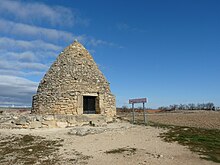Fuendetodos
| Fuendetodos municipality | ||
|---|---|---|
 Fuendetodos - location view
|
||
| coat of arms | Map of Spain | |
 Help on coat of arms |
|
|
| Basic data | ||
| Autonomous Community : | Aragon | |
| Province : | Zaragoza | |
| Comarca : | Campo de Belchite | |
| Coordinates | 41 ° 21 ′ N , 0 ° 58 ′ W | |
| Height : | 750 msnm | |
| Area : | 62.2 km² | |
| Residents : | 145 (Jan 1, 2019) | |
| Population density : | 2.33 inhabitants / km² | |
| Postal code : | 50142 | |
| Municipality number ( INE ): | 50114 | |
| administration | ||
| Website : | Ayuntamiento de Fuendetodos www.fundacionfuendetodosgoya.org/ Ayuntamiento de Fuendetodos | |
Fuendetodos is a municipality ( municipio ) in northern Spain in the province of Zaragoza in the autonomous community of Aragón . It is the birthplace of the painter Francisco de Goya y Lucientes, born in 1746, and is visited by around 25,000 tourists every year.
location
Fuendetodos is about 55 kilometers (driving distance) south of Saragossa . The city of Calatayud is about 80 kilometers to the west.
Population development
| year | 1960 | 1970 | 1981 | 1991 | 2001 | 2007 |
| Residents | 389 | 234 | 166 | 146 | 176 | 179 |
In the 19th and early 20th centuries Fuendetodos always had between 500 and 700 inhabitants.
economy
The small and rain-free community lived for centuries from agriculture ( dry fields and sheep farming ); There were several limestone quarries in the area . In winter, snow and ice were 'harvested' and stored in stone huts ( neveras or neverones ); there it stayed - depending on the climate - until late summer and was gradually transported to Saragossa by carts. Only in the last few decades have day and holiday tourism been added as an important source of employment and income for the residents. Some wind turbines to generate electricity were also set up.
history
Almost nothing is known about the history of the small town. Since the 14th century it belonged to the manor ( señorio ) of the Fernández de Heredia family, who were also known as Condes de Fuentes ("Fountain Counts").
Attractions
- The most important attraction of the place is the house where Goya was born ( Casa natal de Goya ) - a small, but typical stone house for the area with two floors and a storage floor from the early 18th century with only a few windows. The tiny rooms inside have been redesigned like a museum, but not in keeping with the style.
- Just a few meters away, another traditional house has been converted into a museum ( Museo del Grabado ). Here you can see prints of Goya's famous graphic cycles: Los Caprichos , Desastres de la Guerra , La Tauromaquia and Los Disparates .
- Two bronze Goya busts were set up in the village: a cubist-inspired one from 1978 stands on a plinth in front of the house where he was born; the other, from 1920, was made by the sculptor Julio Antonio and commissioned and paid for by the painter Ignacio Zuloaga , a great admirer of Goya.
- The church of the Nuestra Señora de la Asunción originally dates from the 18th century. Here were some of Goya's youthful works and an altar that was gilded by his father. In the Spanish Civil War , however, the church and its furnishings were destroyed and then rebuilt in a modified form. The baptismal font in which Goya was baptized is still preserved.
- A nature museum ( Espacio de naturaleza Fuendeverde ) has been set up on the outskirts . Immediately next to it are the last remains of a former castle.
- Surroundings
- In the vicinity of the village there were formerly 22 ice cellars ( neverones ), of which only one ( la Culroya ) is well preserved or has been restored. They were simple round stone huts excavated two to three meters deep, the aboveground part of which is modeled on the shepherds' shelters. The 'entrance' was sometimes in the top of the hut, sometimes on the side. The ice was cut into blocks; these were pulled up using ladders and / or rope winches and gradually - by carts and mostly on cool days - transported to the wealthy houses of Saragossa, which had their own small ice cellar.
Web links
- Goya and Fuendetodos - Photo + Info (Spanish)
- Casa natal de Goya - photo + info (spanish)
- Museo del Grabado - Photos + Info (Spanish)
Individual evidence
- ↑ Cifras oficiales de población resultantes de la revisión del Padrón municipal a 1 de enero . Population statistics from the Instituto Nacional de Estadística (population update).



